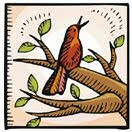Bare-root and twice-transplanted
 |
| Bare-root trees were planted by the thousands during the Great Depression. (FSA/OWI photo) |
When we were doing a lot of planting on our little place, we ordered dozens and dozens of bare-root shrubs from Mellinger's (an Ohio catalog that has now gone out of business, I regret to say.) We also ordered some bare-root trees from Mellingers and several other Midwest-based tree catalogs.
Also we planted a couple dozen bare-root trees that came home from school from our children's biology teacher. He got them in bulk from the state forestry department every spring and passed them out to his students.
The survival rate was not good on the free bare-root trees from the forestry department. They were just tiny seedlings -- a twig with a few strings of root. The poor little trees underwent a lot of rough treatment -- they were bundled and shipped in groups of 100, distributed at school, and carried home on the school bus before they were finally planted. However, we do have some pin oaks and tulip poplars that survived all that abuse and are fine established trees today.
 We had mostly good luck with ordering trees and shrubs from catalogs. Most of those mail-order trees were shipped to us as bare-root plants. Many of the bare-root trees we received from catalogs were sturdy little fellows, nicely rooted and branched. The ones that we didn't kill by overwatering did very well and are big trees now.
We had mostly good luck with ordering trees and shrubs from catalogs. Most of those mail-order trees were shipped to us as bare-root plants. Many of the bare-root trees we received from catalogs were sturdy little fellows, nicely rooted and branched. The ones that we didn't kill by overwatering did very well and are big trees now.The best trees were "twice transplanted", which is a good thing to look for in a bare-root plant's description. It encourages the tree seedlings to develop a dense mass of roots rather than just a few, long, stringy ones.
Twice-transplanting has been good nursery practice for a long time. For example, it's mentioned in advertisements by Herbert A. Jackson of Forest City Nurseries, in Garden and Forest magazine in 1896, "Try our Northern-grown Stock. Nursery-grown from seed and twice transplanted." An Irish newspaper, The Armagh Guardian, carried an advertisement from Coolkill Nursery in 1844: "The Proprietor Respectfully Solicits orders for the above Nursery, which contains a very extensive and general Stock of Forest Trees, all twice transplanted..."
Now is the time to order bare-root trees for early spring planting, so don't dawdle.

 "The power to recognize trees at a glance without examining their leaves or flowers or fruit as they are seen, for example, from the car-window during a railroad journey, can only be acquired by studying them as they grow under all possible conditions over wide areas of territory. Such an attainment may not have much practical value, but once acquired it gives to the possessor a good deal of pleasure which is denied to less fortunate travelers."
"The power to recognize trees at a glance without examining their leaves or flowers or fruit as they are seen, for example, from the car-window during a railroad journey, can only be acquired by studying them as they grow under all possible conditions over wide areas of territory. Such an attainment may not have much practical value, but once acquired it gives to the possessor a good deal of pleasure which is denied to less fortunate travelers."
0 comments -- please add yours:
Post a Comment